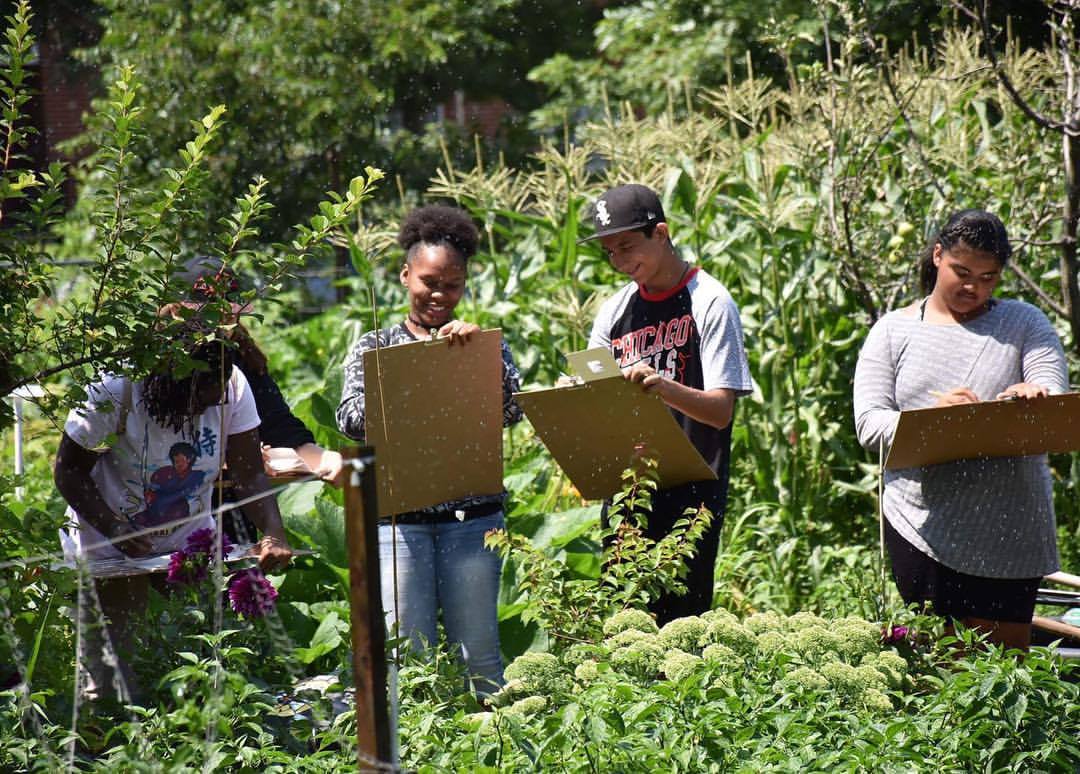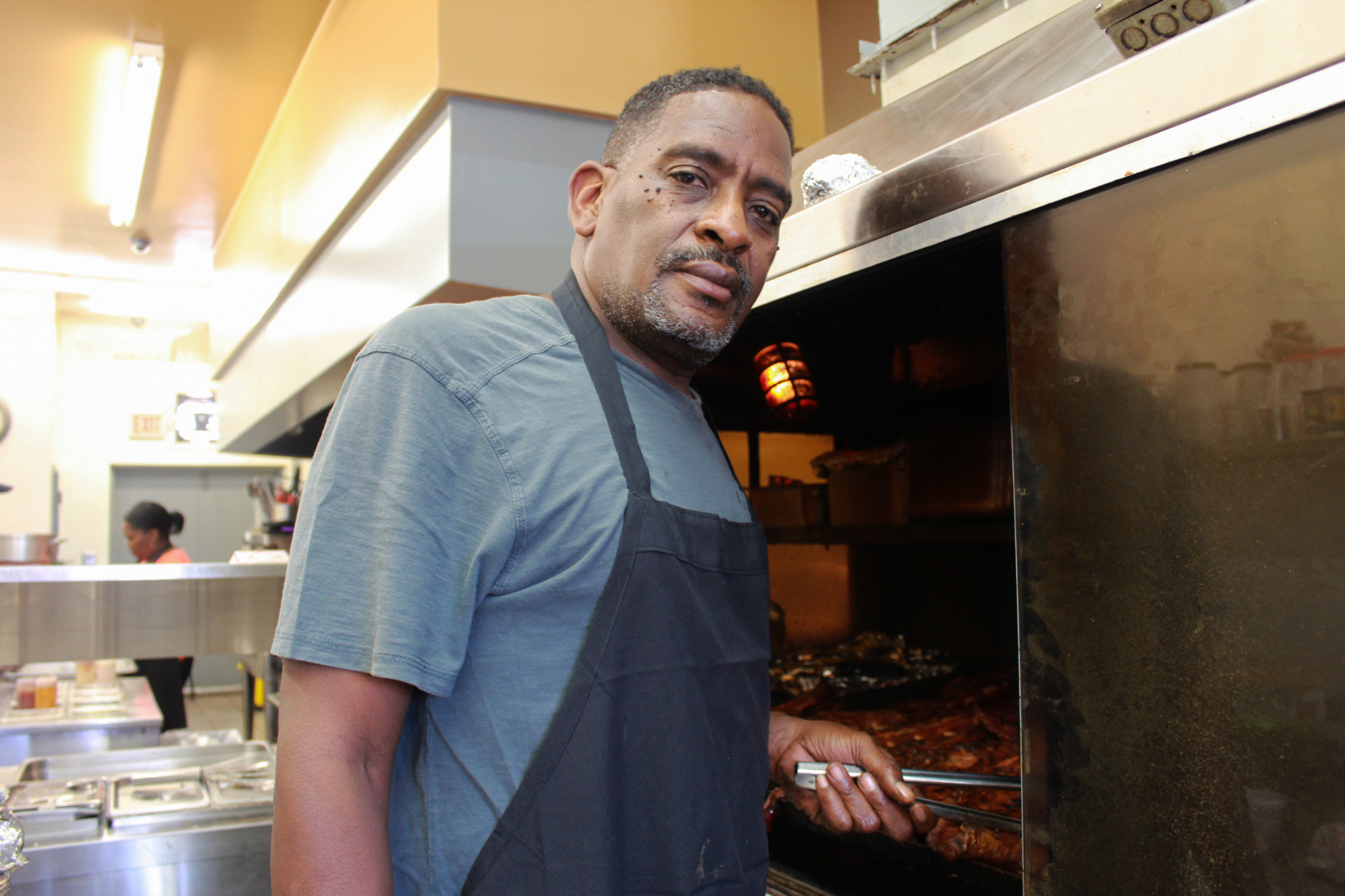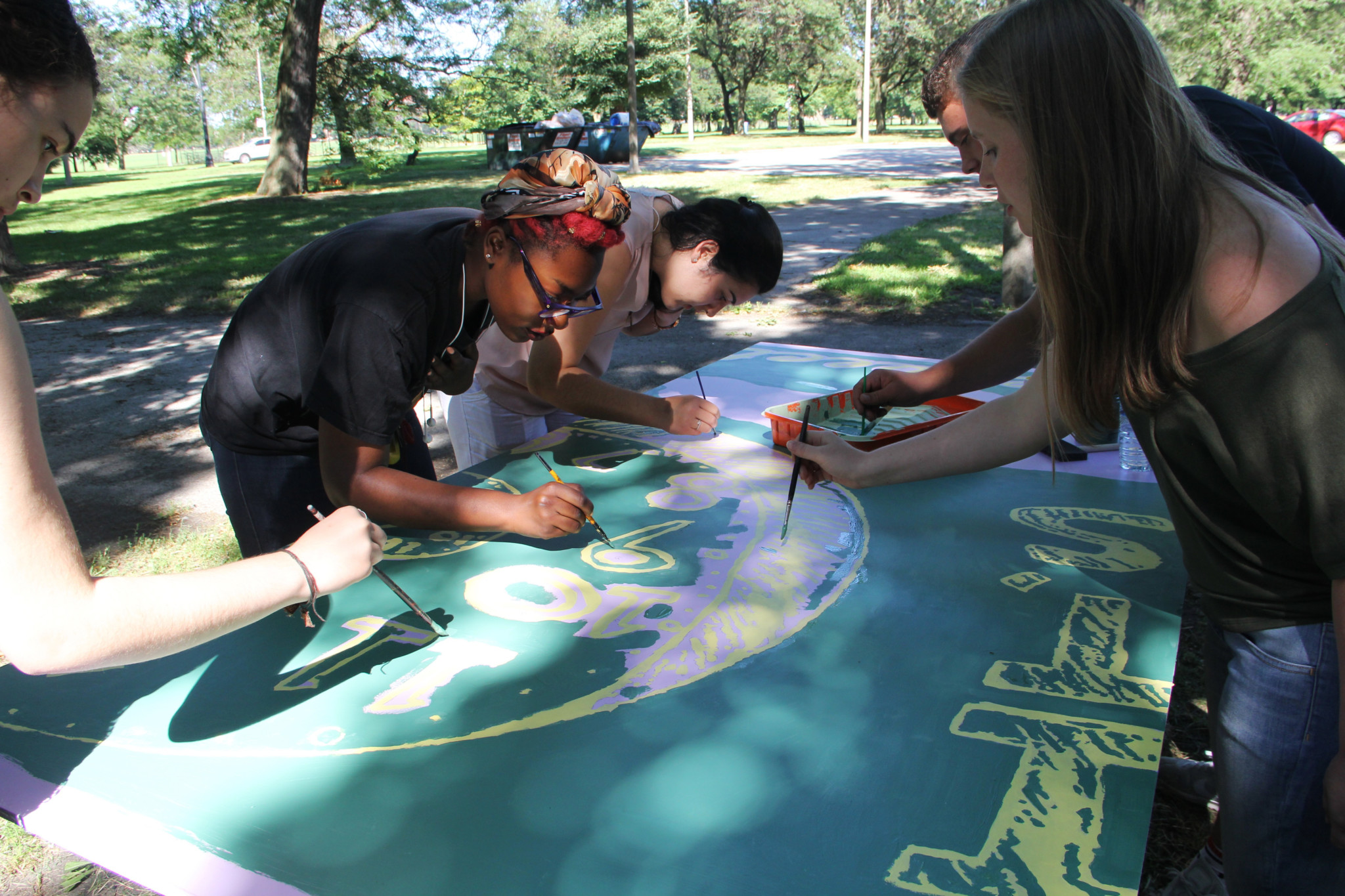- Best Peaches and Herbie
- Best Soon-to-be-Irreversibly Altered Part of the Park District
- Best Vegetarian Burrito
- Best Ancestral Resurrection
- Best Barbecue to Tempt a Vegetarian With
Roman Villarreal is an artist and lifelong resident of South Chicago. He operates Under the Bridge, 10052 S. Ewing Ave.
My name is Roman Villarreal. I was born in 1950 in the neighborhood called The Bush. The house that I lived in when I was a kid was literally across the street from the steel mills. In the early years in the neighborhood, we grew up with the noise, the banging, the clanking of the steel. All our lives it was the noise of the steel mills. When they closed the mills and we had access to the park, it was the first time we ever went to the lake. We never realized how close we were to the lake all these years.
My whole family, they came from Texas, migrant workers, and they settled here in the early fifties. I was the first one born in Chicago. They were working in the fields in Michigan, and the word got out that the mill was hiring workers, so the men from that group—my father happened to be one of them—they took a chance and came here and, lo and behold, they got hired. They had a lot of benefits that you didn’t have in the fields during that period.
When they got here, they didn’t realize they were actually scabs. There was a big strike, and they started hiring all these men. The good thing was that afterward they absorbed them into the mill and they were able to keep working. They usually [would] have got rid of them.
I went to work in the mill in 1967—I was seventeen years old. I was going to Bowen High School, and my old man felt that I was hanging around the street too much, so his way of solving the problem was putting me to work three to eleven. So I was going to school and then working a full shift here in the mill. So I did that all the way up until ’68 when I won the lotto to the military. At that time they called it the lotto, but [it was] the strangest thing for us in this community, because it was the only thing we ever won. And our numbers were real short numbers. This community of all the communities in the United States, this was the one that suffered the most casualties in such a short area. That’s why the memorial at Guadalupe Church is rather important, because that’s the only memory that we have of these young men during that period. It was such an important thing because we were the only ones that suffered that much in one small area. I was fortunate enough to escape the war part of it.
It was during the period when the mills were closing that I made the big decision no longer to work for anybody, and I became a full-time artist. I realized that [with] persistence on my part, [my family] could survive doing this. We never asked for grants, we never asked for donations, we never asked for nothing, absolutely nothing. The majority of the time, all that we’ve done to keep the arts alive in our community is out of pocket—art for the sake of the arts. The new alderman here now, Sue Garza, her father [Ed Sadlowski Garza] was our union leader—Local 65. He was a really interesting person to know in your own life because he was a real powerful man. That’s a role model to a lot of us. The people that we grew up around here who were really the shakers and the movers didn’t ask for nothing.
There’s another group of people that are greedy and they’re doing all this for just the sake of whatever they could pocket, whatever money, and these are the people that have brought some of the plight to this community with the petcoke and all these chemical things. In the early years it was getting ridiculous—the powder. If you lived in that area on the East Side, your house all of a sudden started getting this dark sheen on the walls and on the outside of your house and all that stuff. The solution—you have to laugh—of the powers that be at the time: close your windows.
Try to solve the big picture. We know what it is—it’s economics. After the mills, this neighborhood went downhill all the way. In the process families were destroyed. Alcohol, drugs, abuse, everything that you could possibly think of created this mess. We know the solution to our problem is one thing that has to happen, and it’s not gonna happen soon—there is no work. But you can start training.
The only other solution that a lot of us in this community have is to not depend too much on what’s going on and try to solve our own problems. Right now, for instance, we have a community [group]. We got plenty of lots on Commercial Avenue, a lot of abandoned stuff, so they’re starting to clean them up, spruce them up, through this funding that they have. They’re limited because they can only do so much. But there has to be one more element in it, and that element has to be the arts. Because it’s a proven fact in all these other communities, and we can use examples in Chicago: Pilsen, Logan Square, Bronzeville. The arts is part of bringing communities back.
Being in the art world, my concentration is to keep the arts alive, the art movement, and try to change the way the communities deal with their young artists—not as vandals. Because they’re hungry, they want to learn. Don’t look at them as street thugs and all this, because they’re not.
Best Peaches and Herbie
SkyART Community Garden

Three summers ago, near the fence at the back corner of SkyART’s community garden, I watched plums and peaches burst onto the trees sometime during mid-July. The teen interns and I harvested them by climbing onto ladders and knocking them down with a stick. We carried our bounty back to the art center a few blocks away, where we used them in cooking classes and sent them home with students and staff. My coworker taught me to delve in first with a knife, to ensure the fruit was clear of bugs, before eating the freshest peaches and plums I’d ever tasted.
The trees I adored are among thirty—including cherry, apple, pear, and apricot—in a spacious garden on the site of what was once a U.S. Steel parking lot. SkyART, a nonprofit that provides art programming for youth in South Chicago and surrounding areas, began developing the garden in 2003. The existing soil in the neighborhood contains toxic levels of chemicals, byproducts from the nearby steel mill’s blast furnaces. So SkyART, in partnership with NeighborSpace, arranges to have a truckload of safe soil brought in at the beginning of each gardening season to ensure that the produce is non-toxic. Twenty-two community members living near the garden have their own plots, according to Sarah Ward, executive director of SkyART. Many are immigrants from Mexico with farming experience. SkyART has its own plots, too, and uses the produce to make healthy snacks for kids. Sometimes, the kids visit the garden to pick up leaves, sticks, and other natural materials to incorporate into art projects.
The garden is managed by Herbie, an experienced gardener with a lot of patience. When I showed up to work in the garden that summer, he was there almost every day to help me. “Hi mija,” he’d say when I arrived with a group of the interns or young kids. Then he’d show us how to stake tomatoes, weed and turn over plots, and give watermelon seedlings plenty of water. That summer, we used produce to teach cooking classes: the kids and I picked zucchinis and their flowers for quesadillas, mint for a lemonade recipe, green beans. This year, Ward said, the garden yielded a bountiful harvest of tomatoes and peppers. (Mari Cohen)
SkyART Community Garden, 88th St. and Brandon Ave. (773) 731-9287. skyart.org
Best Soon-to-be-Irreversibly Altered Part of the Park District
The South Shore Nature Sanctuary
The South Shore Nature Sanctuary is nestled behind the Cultural Center, just north of the back half of a modest nine-hole golf course. The opening to the sanctuary is a tunnel flanked by dunes; entering it is like walking into a gully, or putting your ear to the folds of a seashell. After a few steps, the cries of children on the beach fall away and are replaced by the gentle, ambient wash of the lake. Inside, bees and butterflies—cloudless sulphurs, a lone monarch butterfly—fly around, flirting with the flowers: fire pinks, blazing stars, purple coneflowers, and milkweed, the particular favorite of the monarch. (It will only eat leaves from or lay eggs on plants of that species.) It’s not a big garden, with short looping pathways and a few fire pits near the water, but it is quietly beautiful.
It may also be disappearing soon, at least in part. The twelfth hole of the planned Tiger Woods Golf Course would sprawl across the northern end of the sanctuary, razing part of the butterfly meadow and all of the fire pits in favor of fairway and green. As an employee of the design firm behind the course put it at a public meeting, “The holes are going to be absolutely spectacular. [Number] twelve will have a peninsula green, water right, left and long, with a marquee snapshot of downtown Chicago.” Though the city has promised, euphemistically, that the percentage of acreage in the area taken up by golf will not change, residents still don’t know where the lost land will be replaced, or whether the existing habitat will be recreated. And so this year, while you still can, it may be worth traveling to the small sanctuary to admire the monarchs as they pass through on their way to Mexico. (Christian Belanger)
South Shore Nature Sanctuary, 7059 South Shore Dr. 6am–11pm. chicagoparkdistrict.com
Best Vegetarian Burrito
El Guero Supermercado
As a vegetarian, I sometimes find it difficult to find satisfying Mexican food; often, it seems like my options extend only to tortas and tacos stuffed with improbably voluminous lettuce leaves, accompanied by a few thin slices of avocado. (If I’m downtown—or in hyper-developed Hyde Park—I can overpay for Chipotle’s sofritas, the bland tofu base of an already-bland chain.) But there are exceptions, like the sweet and savory vegan gems at Yvolina’s Tamales in Pilsen, and, as I discovered this summer, the rajas burrito at El Guero Supermercado along Commercial Avenue.
Like so many of the city’s best taquerias, El Guero is in a supermarket, with a cramped kitchen, one waitress, and a half-dozen tables partitioned off from the grocery aisles. The quesadillas are a good option (plated prettily, tasty), but it’s the rajas burrito that’s worth getting for cheap. Strips of roasted poblano chiles are crammed into the well-griddled tortilla with plenty of melted cheese, making for a burrito flavorful and messy enough to be deeply satisfying. It may not satiate your meat-eating friends, but at least you won’t spend the next few hours extricating leafy greens from between your teeth. (Christian Belanger)
El Guero Supermercado, 9029 S. Commercial Ave. Monday–Thursday, 10am–midnight; Friday and Saturday, 10am–1am; Sunday, 11am–midnight
Best Ancestral Resurrection
Universal Alley Jazz Jam
The Universal Alley Jazz Jam has only been at its current location, an empty lot on 71st Street between Constance and Ridgeland, for the last decade, but its roots stretch back further, into the Bronzeville back alleys where, in the fifties, neighbors would sit and spin records from their open garages. Eventually, musicians set up and began playing, and an ecosystem of informal jazz flourished. Among the players was Dr. Siddha Webber, a native Chicagoan who returned from college at Dartmouth and took a job as a social worker before eventually becoming a theologian and naprapath. In the eighties, after the scene had died down, Dr. Webber slowly began to revive it, changing the name to the Universal Alley Jazz Jam after a poem he wrote. (An excerpt: “Universal Alley is for all to SEE to be RAISED to TRUTH because there is only that that is CONSCIOUS.”) The jam bounced around in Bronzeville and Kenwood for a while before settling on 71st Street, next to the Black United Fund of Illinois building.
Dr. Webber died in August of 2016. For years, he had been paying for the Jazz Jam out of his own pocket, over $10,000 for each summer’s edition. Since then, a group of people involved with the Jam, including his daughter, Karma, have carried it forward, relying on donations and discounted rates from musicians. Karma says they’re trying to become a nonprofit, but it’s a long, arduous process. Still, it’ll be back next summer, starting the weekend after the Fourth of July.
Walk through the western part of South Shore on a Saturday afternoon during the summer, and you’ll probably hear the music, if they’re playing, before you see the mural. Dr. Webber was a muralist—he painted fifty-seven across Chicago, often involving local residents walking by in the project—but this one isn’t his. Still, it’s good-looking, bright and vaguely education-themed, with pencils and protractors painted ten feet up on the wall, but the music is better, whether it’s Sam Cooke (sung by a nine-year-old), Billie Holiday (sung by an impersonator), or vaguely tribal free jazz (no vocals) played by Ancestral Resurrection, Dr. Webber’s old ensemble. Next weekend, come back, bring your own lawn chair, and settle in for a chat with your neighbor. Throw a few bucks into the donation box being passed around—it’s much needed. (Christian Belanger)
Universal Alley Jazz Jam, 1801 E. 71st St. Saturdays during the summer, 3pm–7pm.
Best Barbecue to Tempt a Vegetarian
The Slab Bar-B-Que

While waiting for this very late reporter to arrive at the the Slab Bar-B-Que, a longtime vegetarian and fellow Weekly editor was provided with a free rib tip sample. Not wanting to seem rude or awkwardly explain why he, a vegetarian, was in a barbecue restaurant, he ate the rib tip. He later admitted that it made him “miss meat for a few days” afterwards. As an enthusiastic meat-eater, I can confirm: it even made me miss meat for a few days, and there was no lapse in my meat-eating schedule. The ideal way to consume the Slab’s offerings—I opted for the substantial tip-and-link combo, with a side of mac and cheese for my penitent friend—is to take them half a mile east, through the South Shore Cultural Center, to the beach. Be sure to do so before it gets too cold. (Sam Stecklow)
The Slab Bar-B-Que. 1918 E. 71st St. Monday–Thursday, 11am–9pm; Friday–Saturday, 11am–11pm; Sunday, 11am–7pm. (773) 966-5018. slabbbq.com

